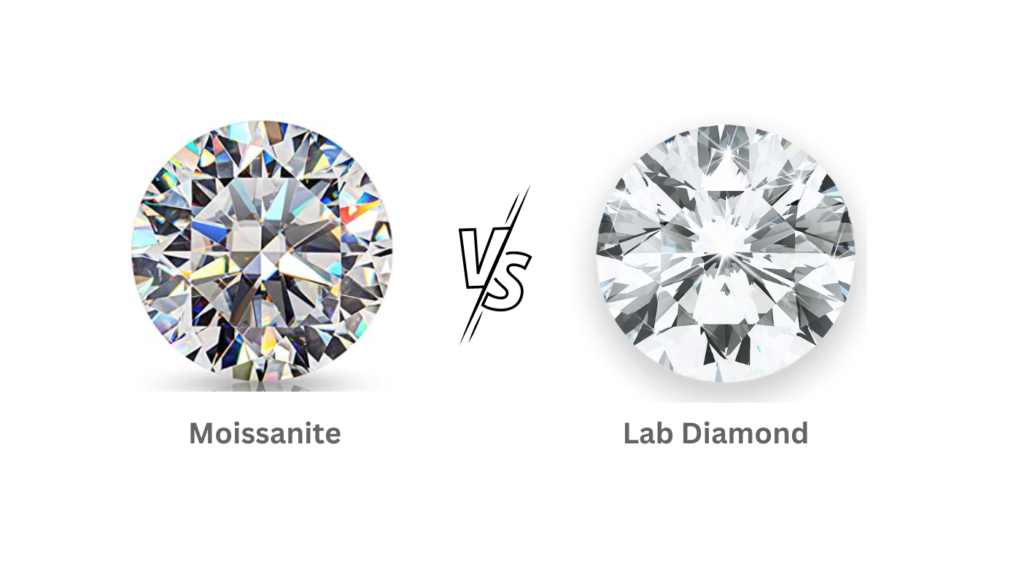Many people can get confused about the specifics when it comes to all the different types of diamond looking stones out there. It is important for you to know the difference between all of these beautiful sparkles, so that you know the value of what you are buying.
There are Diamond simulants, Plastic gemstones, Foil-backs, cubic zirconias, Swarovski crystals, glass paste, moissanite and many more.
As you can see in this image, different stones have different light refractivity, or sparkle.
Diamond Simulants:
General term: Encompasses any gemstone that imitates the look of a diamond but has a different chemical composition.
Examples: Cubic zirconia (CZ), moissanite, and even some plastics can be considered diamond simulants.
Key points: They are typically less expensive than diamonds and may have different brilliance or durability.
Not real diamonds: They don’t share the same physical and chemical properties as real diamonds.
Cubic Zirconia (CZ):
A specific type of diamond simulant: Made from zirconium dioxide, a colorless, crystalline material.
Popular choice: Known for its affordability and brilliance.
Less durable: Scratches easier than diamonds and may chip over time.
Heavier than diamonds: A one-carat CZ will feel heavier than a one-carat diamond.
Plastic Gemstones:
Inexpensive option: Made of acrylic or other plastics.
Appearance: Can vary in quality, some may look cheap and unconvincing as replacements for diamonds.
Not very durable: Can scratch easily and will not withstand everyday wear.
Foil-Backs:
Less about imitation, more about appearance: Glass or plastic with a metallic backing to enhance brilliance.
Common use: In costume jewellery where sparkle is more important than mimicking diamonds. Often the type of bling found in and around low to medium priced watches, and costume or fashion jewellery.
Not as durable: The backing can deteriorate over time.
Swarovski Crystals:
Not diamond simulants: Made from lead crystal glass with a special coating. (No longer actually includes lead in its manufacture)
Known for their sparkle and rainbow effect (fire) which differs from diamonds.
Used in fashion jewellery and decorative items, not fine jewellery like engagement rings.
More affordable compared to diamonds and even cubic zirconia.
Glass Paste:
Historic use: An early simulant made from glass, often colored to imitate different gemstones, not just diamonds.
Not very durable: Can be easily scratched or chipped.
Lesser use today: Largely replaced by more convincing simulants like cubic zirconia.
Moissanite:
A unique diamond simulant: A very very rare naturally occurring gemstone made of silicon carbide, due to its scarcity it quickly became lab produced and is now only lab created.
Properties: Exceptionally brilliant, can even surpass diamonds in fire.
More durable than CZ: Closer to diamonds on the hardness scale, but still not as hard.
Gaining popularity as a more ethical and affordable alternative to mined diamonds.
Lab-grown diamonds are fundamentally different from diamond simulants, plastic gemstones, foil-backs, Swarovski crystals, and glass paste in one key aspect: composition.
Lab Diamonds:
Chemically and physically identical to mined diamonds, they are real diamonds. They are created in a controlled environment using extreme heat and pressure to mimic natural diamond formation.
Diamond simulants and the other terms you mentioned are all not real diamonds. They have different chemical structures and properties that result in variations in brilliance, durability, and value. Here’s a breakdown of the key differences:
Chemical Makeup: Lab diamonds are pure carbon crystals, just like mined diamonds. Simulants and other options have different compositions, like zirconium dioxide (CZ), plastic, glass, or silicon carbide (moissanite).
Durability: Lab diamonds are incredibly hard, like mined diamonds. Simulants and other options can range from soft plastics to relatively hard moissanite, but none match a diamond’s durability.
Brilliance: Lab diamonds can refract light exactly the same as mined diamonds, offering excellent sparkle. Some simulants like CZ can be quite sparkly, while others like glass paste may be dull. Moissanite can even be more sparkly colour wise than diamonds in certain lighting conditions, however diamonds will always have the upper hand when it comes to the bright white sparkle.
Value: Lab diamonds hold a similar value ratio to mined diamonds, though they are worth about 50% less. Simulants and other options are significantly cheaper.
Here’s an analogy: Think of diamonds as pure gold. Lab diamonds are like gold minted from a different source, still valuable and the real deal. Diamond simulants and other options are like gold-plated materials – they may look similar but aren’t pure gold and have a lesser value.



